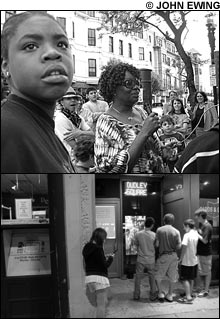
DOUBLE VISION: Dudley neighbors (top) meet the kids from Brookline (bottom), despite the fact that their paths seldom cross. |
Three kids camped out in front of Brookline Booksmith’s storefront window in the middle of June and peered into a video screen broadcasting real-time views of a street corner in Dudley Square. Every so often a person would pass by, and the kids would shout: “Guy in the black shirt!” “Dude!” “Hey, you!” Eventually, a black man on crutches approached the Roxbury camera.“What happened to your leg?” asked one member of the group.
“I banged my knee and it got infected.”
“Cool!” the kid exclaimed.
Children, it seems, got the biggest kick out of the digital-media art installation, “Virtual Street Corners,” which linked up Coolidge Corner, Brookline, and Dudley Square, Roxbury, from June 12 through June 21 this month via a 24-hour, live digital feed. But that wasn’t the intent.
When John Ewing, a Mission Hill–based artist, dreamed up the project in 2004, he planned to place video links in three cities: Tel Aviv, Ramallah, and New York.
“All of the information we get through the media and the government is not always reliable,” he says. “The idea was to set up an alternative network that would be kind of a people-to-people diplomacy.”
Ewing had laid some of the groundwork before things fell apart. “The folks in Ramallah said they just couldn’t talk at all to Tel Aviv, and then there were all these issues of translation, security. . . . So then I thought, why not start out at a local level?”
Coolidge Corner and Dudley Square may not be as bitterly divided as the war-torn Middle Eastern cities, but they’re divided nonetheless.
“[O]ne is predominantly white and one is predominantly black — or black and Latino, and I guess the other is white and Asian,” explains Ewing, touching on the obvious. “Obviously when you look, there isn’t a lot of crossover between the two.”
To drive his point home, Ewing asked 25 people in each of the locales to describe their routes around the city on any given day. What he discovered was that the two groups’ paths almost never intersected (the map on which he scrawled the 50 routes is up on his Web site, virtualcorners.net).
Aside from a few brief exchanges I witnessed, it appeared there was little video interaction between the hubs, either. The device’s audio even began to fail — not surprising since video-conferencing technology is more suited to the corporate conference room than the noisy, unpredictable street. (Ewing insists the installation was used plenty, and that later that night, after he hooked up microphones, City Councilor Chuck Turner stopped by for a pre-planned chat with BU prof Hillel Levine, about, among other things, offering free bus rides between the neighborhoods.)
Still, the project did manage to bring the block to life. People began to talk frankly about subjects rarely broached while out in the street.
“Why would anyone want to see what Roxbury is doing?” a white man in a too-tight T-shirt asked a woman standing nearby. “Why put it in Dudley, why not Harvard Square? People are smart there. All you’re gonna see there is crime.”
After the man left, the woman called him a racist. It wasn’t pretty, to be sure. But just then, her 13-year-old boy, Eli Cherry, touched on the project’s worth.
“It’s supposed to put an end to conflicts like that,” he said. “That’s what this is here for.”